Unit 7 & 19: Social Policy and Contemporary Issues: Equality Act 2010
VerifiedAdded on 2020/05/01
|14
|3342
|190
Report
AI Summary
This report examines the Equality Act 2010, focusing on its formation, the nine protected characteristics, and its relevance to health and social care. It investigates the issue of disability within the context of the Act, analyzing its impact on public concern and media representation. The report details the process of how the Act was formed, the ideologies that influenced it, and the techniques used to disseminate information about it. It evaluates how the public assesses the reliability of media information related to the Act, considering the roles of various organizations and the media in shaping public opinion. The analysis includes a critical assessment of the techniques employed and the public's reaction, demonstrating an understanding of complex problems with multiple variables and the ability to identify and evaluate sources for the assignment.
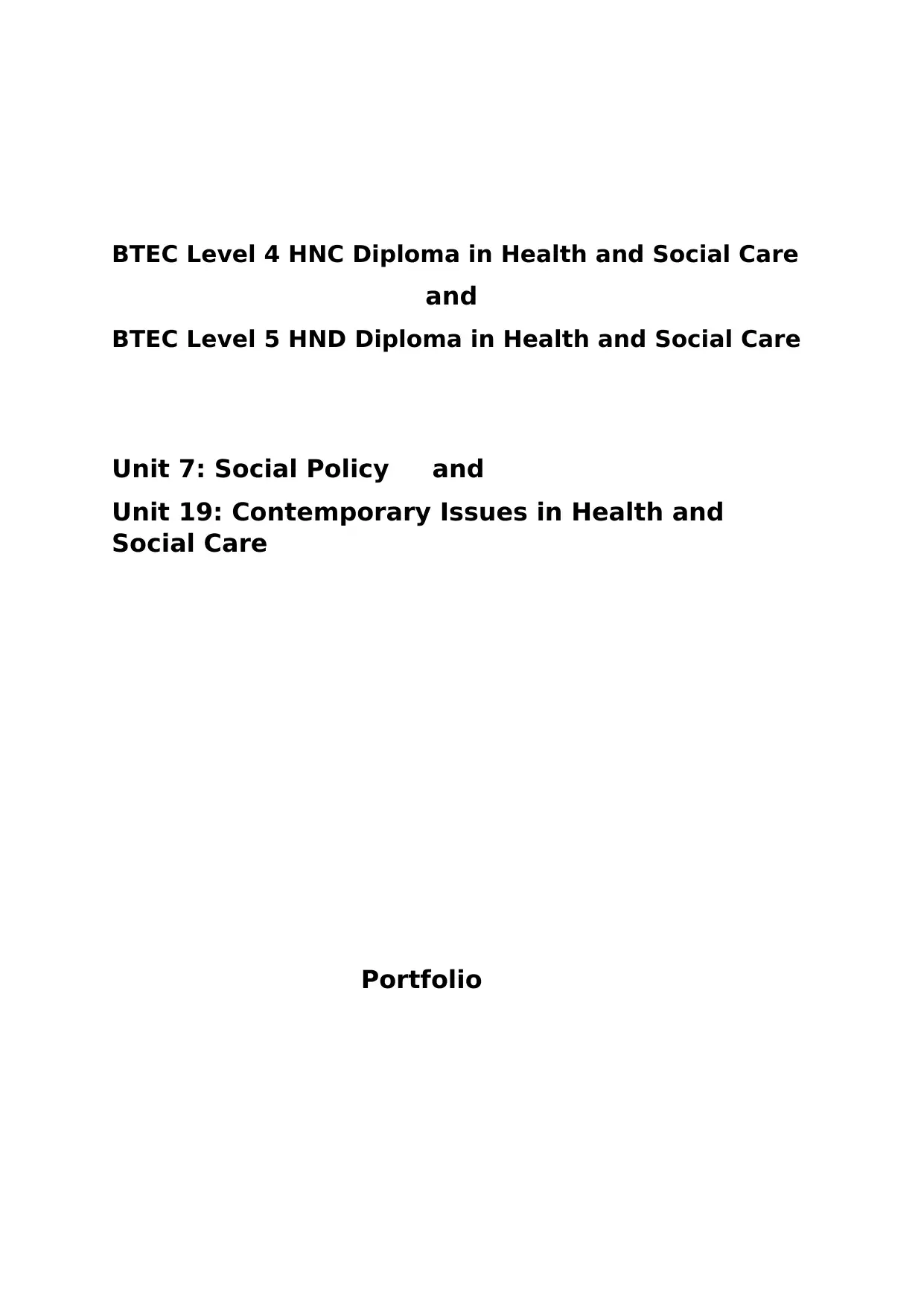
BTEC Level 4 HNC Diploma in Health and Social Care
and
BTEC Level 5 HND Diploma in Health and Social Care
Unit 7: Social Policy and
Unit 19: Contemporary Issues in Health and
Social Care
Portfolio
and
BTEC Level 5 HND Diploma in Health and Social Care
Unit 7: Social Policy and
Unit 19: Contemporary Issues in Health and
Social Care
Portfolio
Paraphrase This Document
Need a fresh take? Get an instant paraphrase of this document with our AI Paraphraser
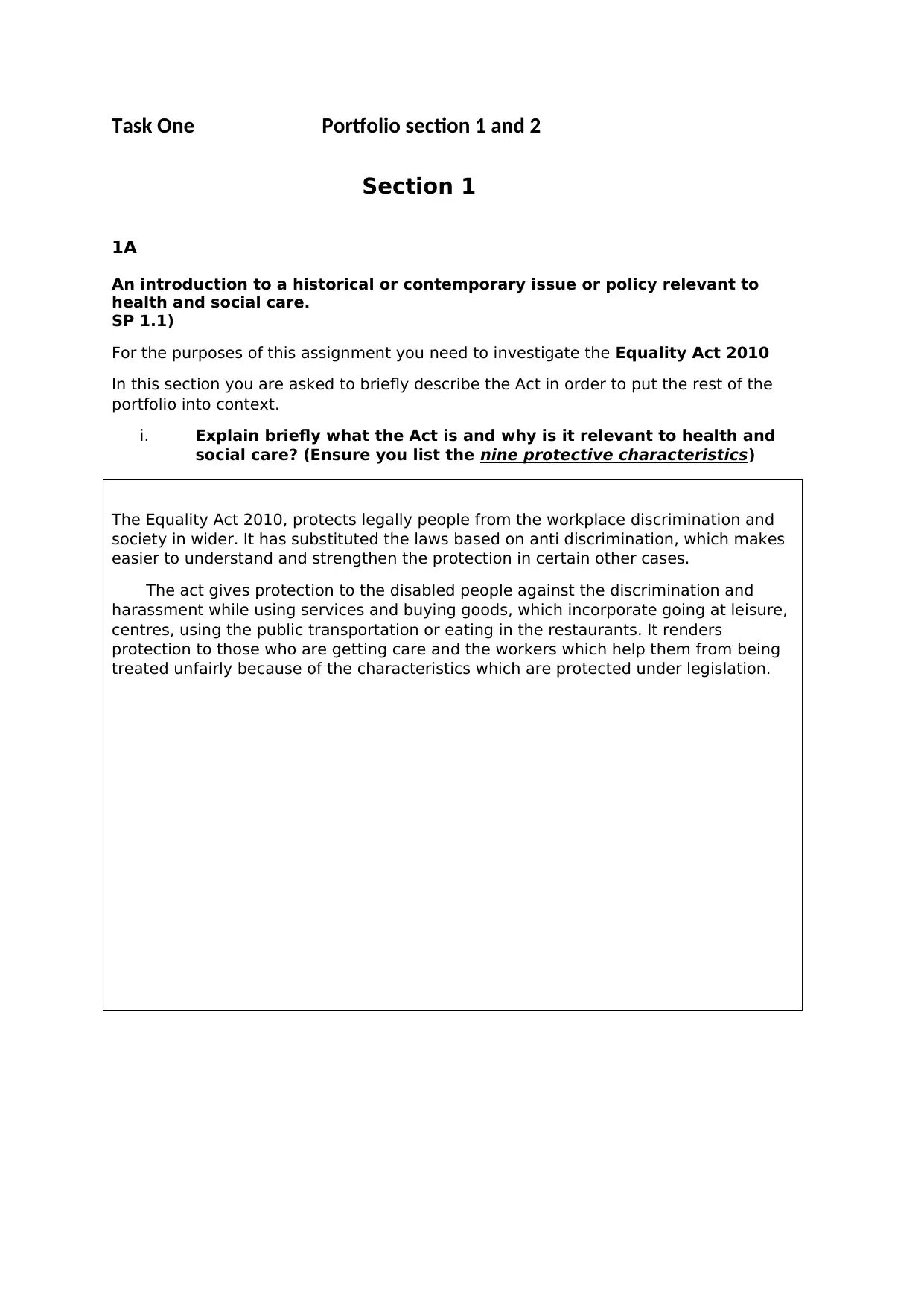
Task One Portfolio section 1 and 2
Section 1
1A
An introduction to a historical or contemporary issue or policy relevant to
health and social care.
SP 1.1)
For the purposes of this assignment you need to investigate the Equality Act 2010
In this section you are asked to briefly describe the Act in order to put the rest of the
portfolio into context.
i. Explain briefly what the Act is and why is it relevant to health and
social care? (Ensure you list the nine protective characteristics)
The Equality Act 2010, protects legally people from the workplace discrimination and
society in wider. It has substituted the laws based on anti discrimination, which makes
easier to understand and strengthen the protection in certain other cases.
The act gives protection to the disabled people against the discrimination and
harassment while using services and buying goods, which incorporate going at leisure,
centres, using the public transportation or eating in the restaurants. It renders
protection to those who are getting care and the workers which help them from being
treated unfairly because of the characteristics which are protected under legislation.
Section 1
1A
An introduction to a historical or contemporary issue or policy relevant to
health and social care.
SP 1.1)
For the purposes of this assignment you need to investigate the Equality Act 2010
In this section you are asked to briefly describe the Act in order to put the rest of the
portfolio into context.
i. Explain briefly what the Act is and why is it relevant to health and
social care? (Ensure you list the nine protective characteristics)
The Equality Act 2010, protects legally people from the workplace discrimination and
society in wider. It has substituted the laws based on anti discrimination, which makes
easier to understand and strengthen the protection in certain other cases.
The act gives protection to the disabled people against the discrimination and
harassment while using services and buying goods, which incorporate going at leisure,
centres, using the public transportation or eating in the restaurants. It renders
protection to those who are getting care and the workers which help them from being
treated unfairly because of the characteristics which are protected under legislation.
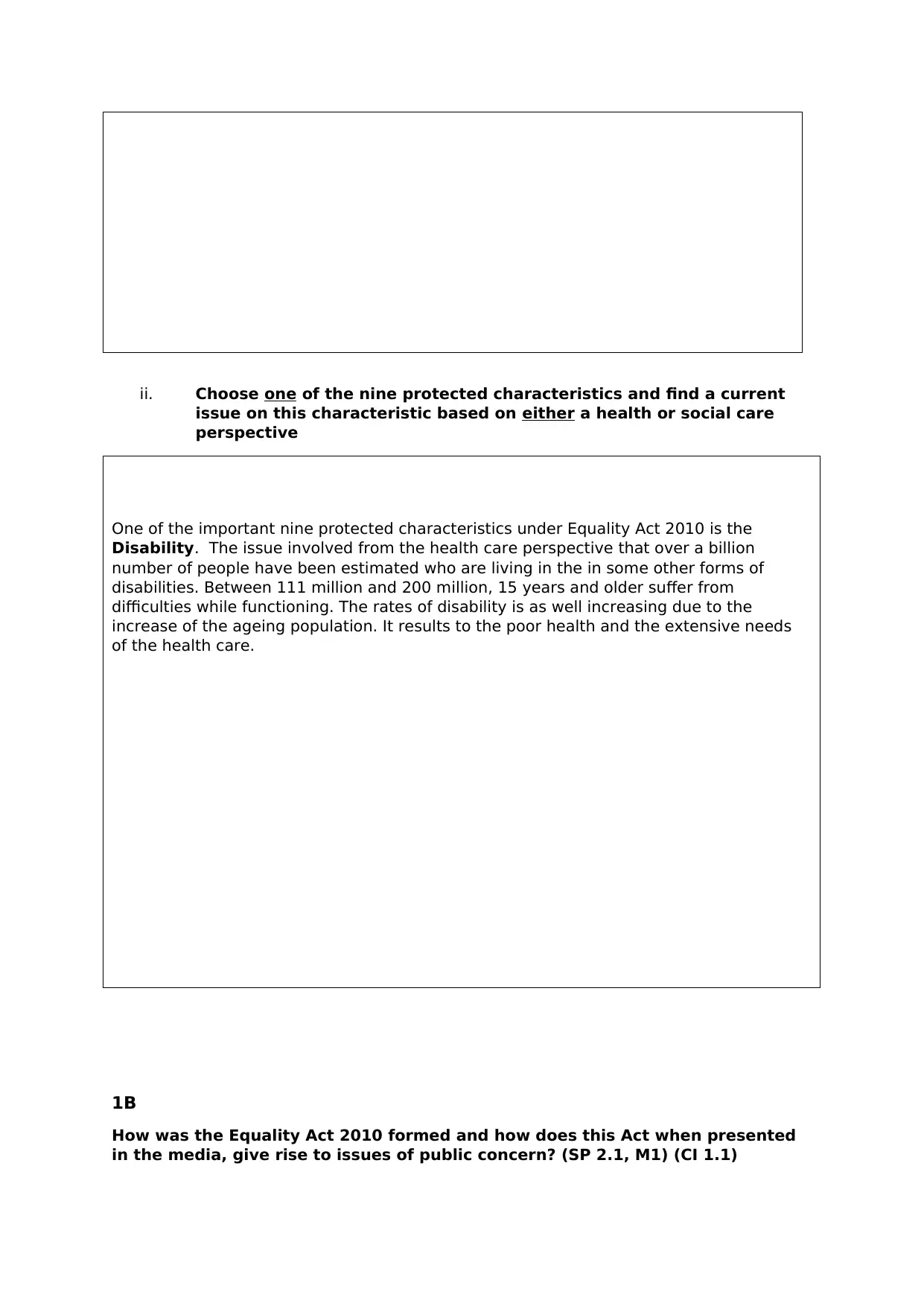
ii. Choose one of the nine protected characteristics and find a current
issue on this characteristic based on either a health or social care
perspective
One of the important nine protected characteristics under Equality Act 2010 is the
Disability. The issue involved from the health care perspective that over a billion
number of people have been estimated who are living in the in some other forms of
disabilities. Between 111 million and 200 million, 15 years and older suffer from
difficulties while functioning. The rates of disability is as well increasing due to the
increase of the ageing population. It results to the poor health and the extensive needs
of the health care.
1B
How was the Equality Act 2010 formed and how does this Act when presented
in the media, give rise to issues of public concern? (SP 2.1, M1) (CI 1.1)
issue on this characteristic based on either a health or social care
perspective
One of the important nine protected characteristics under Equality Act 2010 is the
Disability. The issue involved from the health care perspective that over a billion
number of people have been estimated who are living in the in some other forms of
disabilities. Between 111 million and 200 million, 15 years and older suffer from
difficulties while functioning. The rates of disability is as well increasing due to the
increase of the ageing population. It results to the poor health and the extensive needs
of the health care.
1B
How was the Equality Act 2010 formed and how does this Act when presented
in the media, give rise to issues of public concern? (SP 2.1, M1) (CI 1.1)
⊘ This is a preview!⊘
Do you want full access?
Subscribe today to unlock all pages.

Trusted by 1+ million students worldwide
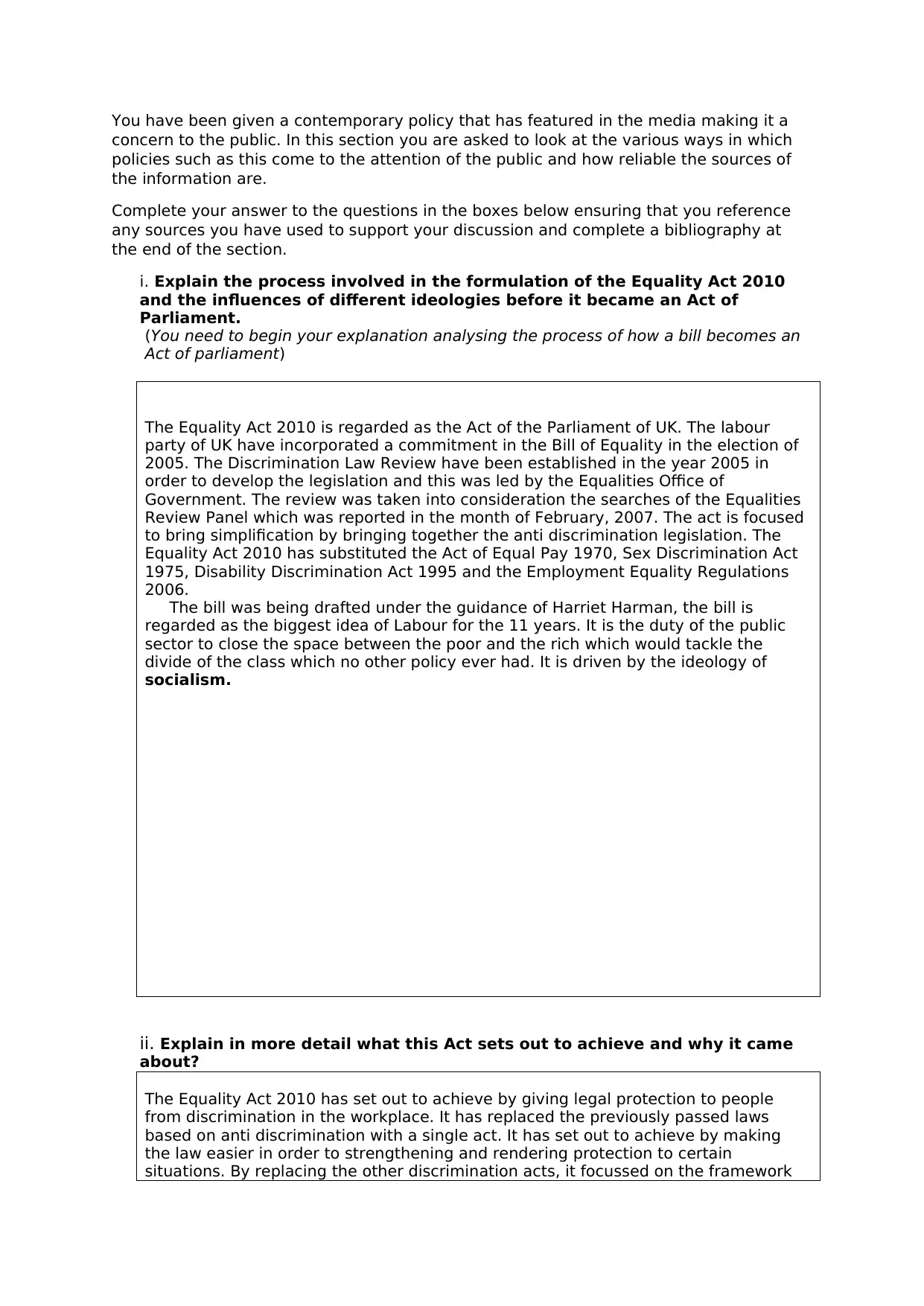
You have been given a contemporary policy that has featured in the media making it a
concern to the public. In this section you are asked to look at the various ways in which
policies such as this come to the attention of the public and how reliable the sources of
the information are.
Complete your answer to the questions in the boxes below ensuring that you reference
any sources you have used to support your discussion and complete a bibliography at
the end of the section.
i. Explain the process involved in the formulation of the Equality Act 2010
and the influences of different ideologies before it became an Act of
Parliament.
(You need to begin your explanation analysing the process of how a bill becomes an
Act of parliament)
The Equality Act 2010 is regarded as the Act of the Parliament of UK. The labour
party of UK have incorporated a commitment in the Bill of Equality in the election of
2005. The Discrimination Law Review have been established in the year 2005 in
order to develop the legislation and this was led by the Equalities Office of
Government. The review was taken into consideration the searches of the Equalities
Review Panel which was reported in the month of February, 2007. The act is focused
to bring simplification by bringing together the anti discrimination legislation. The
Equality Act 2010 has substituted the Act of Equal Pay 1970, Sex Discrimination Act
1975, Disability Discrimination Act 1995 and the Employment Equality Regulations
2006.
The bill was being drafted under the guidance of Harriet Harman, the bill is
regarded as the biggest idea of Labour for the 11 years. It is the duty of the public
sector to close the space between the poor and the rich which would tackle the
divide of the class which no other policy ever had. It is driven by the ideology of
socialism.
ii. Explain in more detail what this Act sets out to achieve and why it came
about?
The Equality Act 2010 has set out to achieve by giving legal protection to people
from discrimination in the workplace. It has replaced the previously passed laws
based on anti discrimination with a single act. It has set out to achieve by making
the law easier in order to strengthening and rendering protection to certain
situations. By replacing the other discrimination acts, it focussed on the framework
concern to the public. In this section you are asked to look at the various ways in which
policies such as this come to the attention of the public and how reliable the sources of
the information are.
Complete your answer to the questions in the boxes below ensuring that you reference
any sources you have used to support your discussion and complete a bibliography at
the end of the section.
i. Explain the process involved in the formulation of the Equality Act 2010
and the influences of different ideologies before it became an Act of
Parliament.
(You need to begin your explanation analysing the process of how a bill becomes an
Act of parliament)
The Equality Act 2010 is regarded as the Act of the Parliament of UK. The labour
party of UK have incorporated a commitment in the Bill of Equality in the election of
2005. The Discrimination Law Review have been established in the year 2005 in
order to develop the legislation and this was led by the Equalities Office of
Government. The review was taken into consideration the searches of the Equalities
Review Panel which was reported in the month of February, 2007. The act is focused
to bring simplification by bringing together the anti discrimination legislation. The
Equality Act 2010 has substituted the Act of Equal Pay 1970, Sex Discrimination Act
1975, Disability Discrimination Act 1995 and the Employment Equality Regulations
2006.
The bill was being drafted under the guidance of Harriet Harman, the bill is
regarded as the biggest idea of Labour for the 11 years. It is the duty of the public
sector to close the space between the poor and the rich which would tackle the
divide of the class which no other policy ever had. It is driven by the ideology of
socialism.
ii. Explain in more detail what this Act sets out to achieve and why it came
about?
The Equality Act 2010 has set out to achieve by giving legal protection to people
from discrimination in the workplace. It has replaced the previously passed laws
based on anti discrimination with a single act. It has set out to achieve by making
the law easier in order to strengthening and rendering protection to certain
situations. By replacing the other discrimination acts, it focussed on the framework
Paraphrase This Document
Need a fresh take? Get an instant paraphrase of this document with our AI Paraphraser
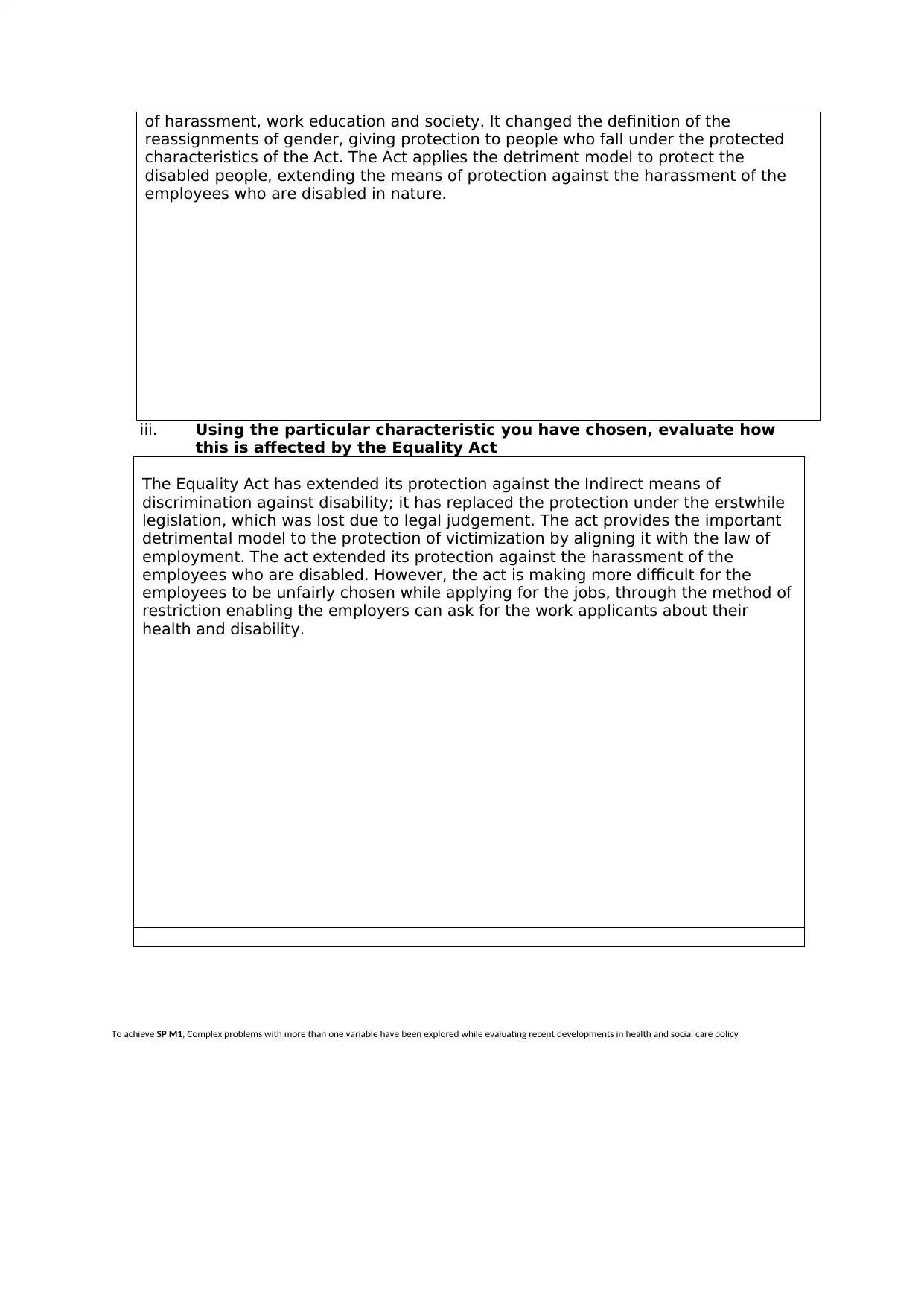
of harassment, work education and society. It changed the definition of the
reassignments of gender, giving protection to people who fall under the protected
characteristics of the Act. The Act applies the detriment model to protect the
disabled people, extending the means of protection against the harassment of the
employees who are disabled in nature.
iii. Using the particular characteristic you have chosen, evaluate how
this is affected by the Equality Act
The Equality Act has extended its protection against the Indirect means of
discrimination against disability; it has replaced the protection under the erstwhile
legislation, which was lost due to legal judgement. The act provides the important
detrimental model to the protection of victimization by aligning it with the law of
employment. The act extended its protection against the harassment of the
employees who are disabled. However, the act is making more difficult for the
employees to be unfairly chosen while applying for the jobs, through the method of
restriction enabling the employers can ask for the work applicants about their
health and disability.
To achieve SP M1, Complex problems with more than one variable have been explored while evaluating recent developments in health and social care policy
reassignments of gender, giving protection to people who fall under the protected
characteristics of the Act. The Act applies the detriment model to protect the
disabled people, extending the means of protection against the harassment of the
employees who are disabled in nature.
iii. Using the particular characteristic you have chosen, evaluate how
this is affected by the Equality Act
The Equality Act has extended its protection against the Indirect means of
discrimination against disability; it has replaced the protection under the erstwhile
legislation, which was lost due to legal judgement. The act provides the important
detrimental model to the protection of victimization by aligning it with the law of
employment. The act extended its protection against the harassment of the
employees who are disabled. However, the act is making more difficult for the
employees to be unfairly chosen while applying for the jobs, through the method of
restriction enabling the employers can ask for the work applicants about their
health and disability.
To achieve SP M1, Complex problems with more than one variable have been explored while evaluating recent developments in health and social care policy

Section 2
2A
Using the characteristic chosen in section 1, explain how the Equality Act
reaches the public domain analysing the different techniques used.
(CI 1.2)
i. How did it get from the original source to be widely available to
everyone?
The act came into force on October 2010. It got its Royal on 8th April and was
commenced on 1st October 2010. It came into force through the act of media and
the individuals were aware about the act through the broadcasting directly from
the UK parliament and slowly with its enforcement, it came under lime light.
2A
Using the characteristic chosen in section 1, explain how the Equality Act
reaches the public domain analysing the different techniques used.
(CI 1.2)
i. How did it get from the original source to be widely available to
everyone?
The act came into force on October 2010. It got its Royal on 8th April and was
commenced on 1st October 2010. It came into force through the act of media and
the individuals were aware about the act through the broadcasting directly from
the UK parliament and slowly with its enforcement, it came under lime light.
⊘ This is a preview!⊘
Do you want full access?
Subscribe today to unlock all pages.

Trusted by 1+ million students worldwide
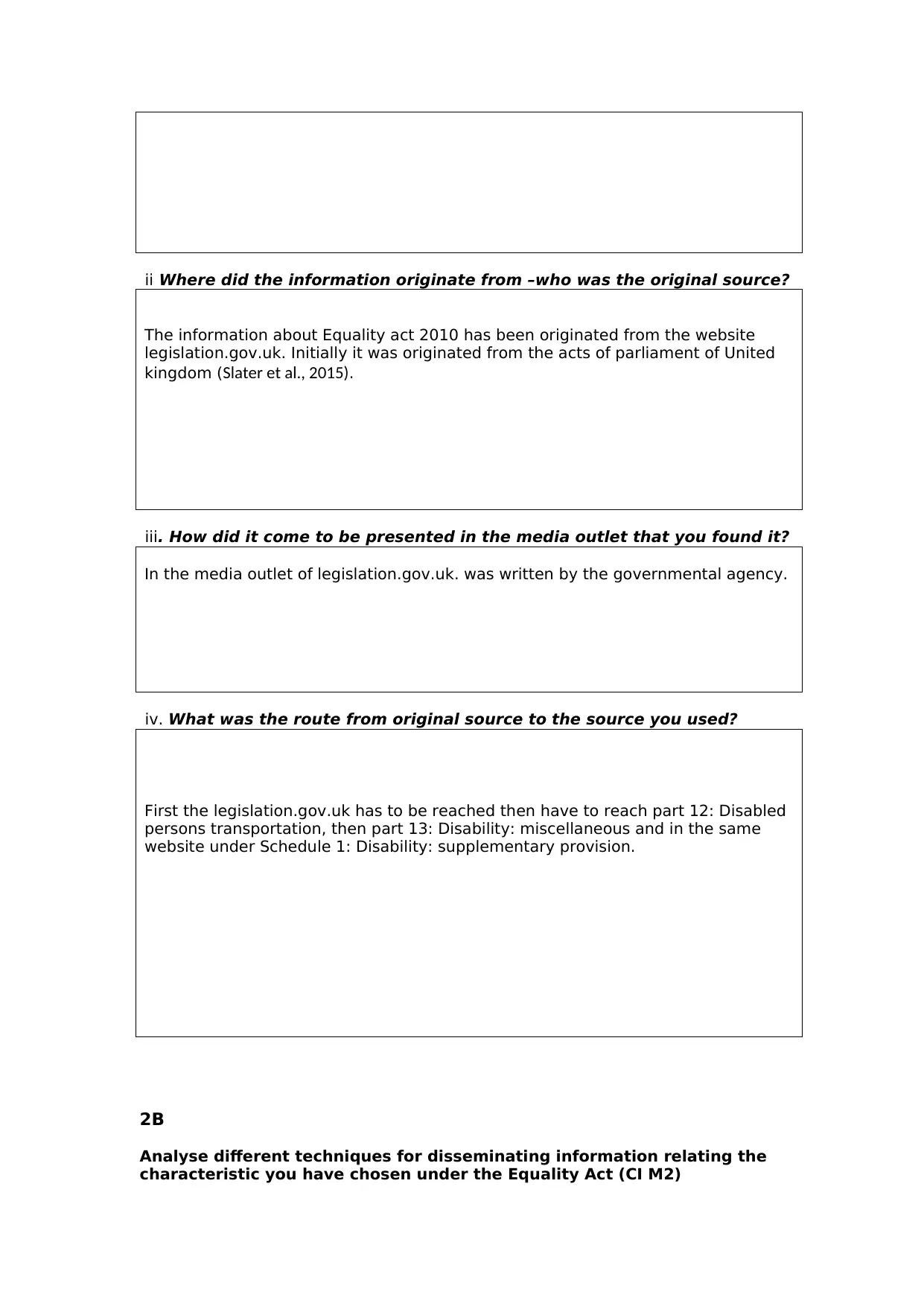
ii Where did the information originate from –who was the original source?
The information about Equality act 2010 has been originated from the website
legislation.gov.uk. Initially it was originated from the acts of parliament of United
kingdom (Slater et al., 2015).
iii. How did it come to be presented in the media outlet that you found it?
In the media outlet of legislation.gov.uk. was written by the governmental agency.
iv. What was the route from original source to the source you used?
First the legislation.gov.uk has to be reached then have to reach part 12: Disabled
persons transportation, then part 13: Disability: miscellaneous and in the same
website under Schedule 1: Disability: supplementary provision.
2B
Analyse different techniques for disseminating information relating the
characteristic you have chosen under the Equality Act (CI M2)
The information about Equality act 2010 has been originated from the website
legislation.gov.uk. Initially it was originated from the acts of parliament of United
kingdom (Slater et al., 2015).
iii. How did it come to be presented in the media outlet that you found it?
In the media outlet of legislation.gov.uk. was written by the governmental agency.
iv. What was the route from original source to the source you used?
First the legislation.gov.uk has to be reached then have to reach part 12: Disabled
persons transportation, then part 13: Disability: miscellaneous and in the same
website under Schedule 1: Disability: supplementary provision.
2B
Analyse different techniques for disseminating information relating the
characteristic you have chosen under the Equality Act (CI M2)
Paraphrase This Document
Need a fresh take? Get an instant paraphrase of this document with our AI Paraphraser
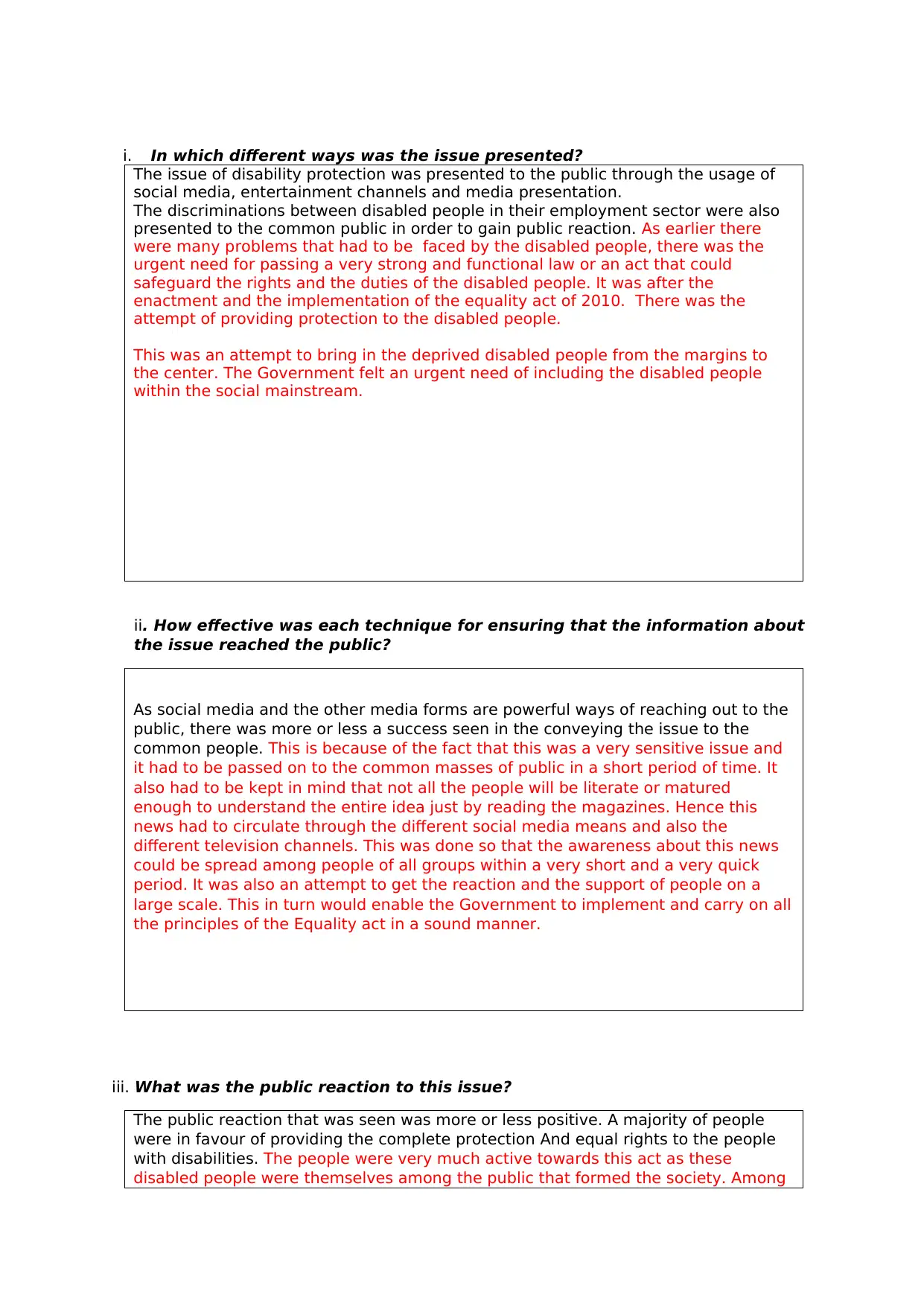
i. In which different ways was the issue presented?
The issue of disability protection was presented to the public through the usage of
social media, entertainment channels and media presentation.
The discriminations between disabled people in their employment sector were also
presented to the common public in order to gain public reaction. As earlier there
were many problems that had to be faced by the disabled people, there was the
urgent need for passing a very strong and functional law or an act that could
safeguard the rights and the duties of the disabled people. It was after the
enactment and the implementation of the equality act of 2010. There was the
attempt of providing protection to the disabled people.
This was an attempt to bring in the deprived disabled people from the margins to
the center. The Government felt an urgent need of including the disabled people
within the social mainstream.
ii. How effective was each technique for ensuring that the information about
the issue reached the public?
As social media and the other media forms are powerful ways of reaching out to the
public, there was more or less a success seen in the conveying the issue to the
common people. This is because of the fact that this was a very sensitive issue and
it had to be passed on to the common masses of public in a short period of time. It
also had to be kept in mind that not all the people will be literate or matured
enough to understand the entire idea just by reading the magazines. Hence this
news had to circulate through the different social media means and also the
different television channels. This was done so that the awareness about this news
could be spread among people of all groups within a very short and a very quick
period. It was also an attempt to get the reaction and the support of people on a
large scale. This in turn would enable the Government to implement and carry on all
the principles of the Equality act in a sound manner.
iii. What was the public reaction to this issue?
The public reaction that was seen was more or less positive. A majority of people
were in favour of providing the complete protection And equal rights to the people
with disabilities. The people were very much active towards this act as these
disabled people were themselves among the public that formed the society. Among
The issue of disability protection was presented to the public through the usage of
social media, entertainment channels and media presentation.
The discriminations between disabled people in their employment sector were also
presented to the common public in order to gain public reaction. As earlier there
were many problems that had to be faced by the disabled people, there was the
urgent need for passing a very strong and functional law or an act that could
safeguard the rights and the duties of the disabled people. It was after the
enactment and the implementation of the equality act of 2010. There was the
attempt of providing protection to the disabled people.
This was an attempt to bring in the deprived disabled people from the margins to
the center. The Government felt an urgent need of including the disabled people
within the social mainstream.
ii. How effective was each technique for ensuring that the information about
the issue reached the public?
As social media and the other media forms are powerful ways of reaching out to the
public, there was more or less a success seen in the conveying the issue to the
common people. This is because of the fact that this was a very sensitive issue and
it had to be passed on to the common masses of public in a short period of time. It
also had to be kept in mind that not all the people will be literate or matured
enough to understand the entire idea just by reading the magazines. Hence this
news had to circulate through the different social media means and also the
different television channels. This was done so that the awareness about this news
could be spread among people of all groups within a very short and a very quick
period. It was also an attempt to get the reaction and the support of people on a
large scale. This in turn would enable the Government to implement and carry on all
the principles of the Equality act in a sound manner.
iii. What was the public reaction to this issue?
The public reaction that was seen was more or less positive. A majority of people
were in favour of providing the complete protection And equal rights to the people
with disabilities. The people were very much active towards this act as these
disabled people were themselves among the public that formed the society. Among
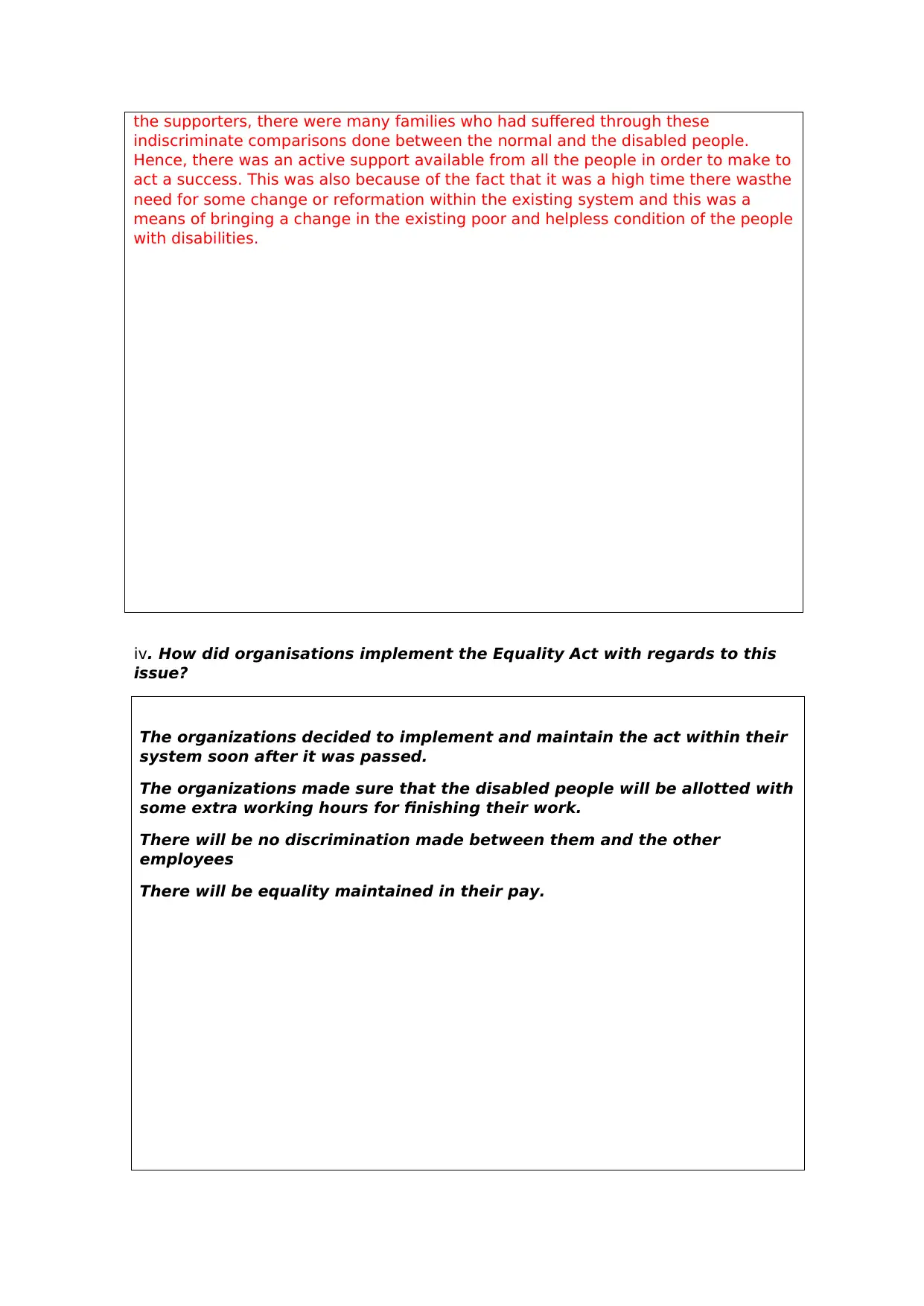
the supporters, there were many families who had suffered through these
indiscriminate comparisons done between the normal and the disabled people.
Hence, there was an active support available from all the people in order to make to
act a success. This was also because of the fact that it was a high time there wasthe
need for some change or reformation within the existing system and this was a
means of bringing a change in the existing poor and helpless condition of the people
with disabilities.
iv. How did organisations implement the Equality Act with regards to this
issue?
The organizations decided to implement and maintain the act within their
system soon after it was passed.
The organizations made sure that the disabled people will be allotted with
some extra working hours for finishing their work.
There will be no discrimination made between them and the other
employees
There will be equality maintained in their pay.
indiscriminate comparisons done between the normal and the disabled people.
Hence, there was an active support available from all the people in order to make to
act a success. This was also because of the fact that it was a high time there wasthe
need for some change or reformation within the existing system and this was a
means of bringing a change in the existing poor and helpless condition of the people
with disabilities.
iv. How did organisations implement the Equality Act with regards to this
issue?
The organizations decided to implement and maintain the act within their
system soon after it was passed.
The organizations made sure that the disabled people will be allotted with
some extra working hours for finishing their work.
There will be no discrimination made between them and the other
employees
There will be equality maintained in their pay.
⊘ This is a preview!⊘
Do you want full access?
Subscribe today to unlock all pages.

Trusted by 1+ million students worldwide
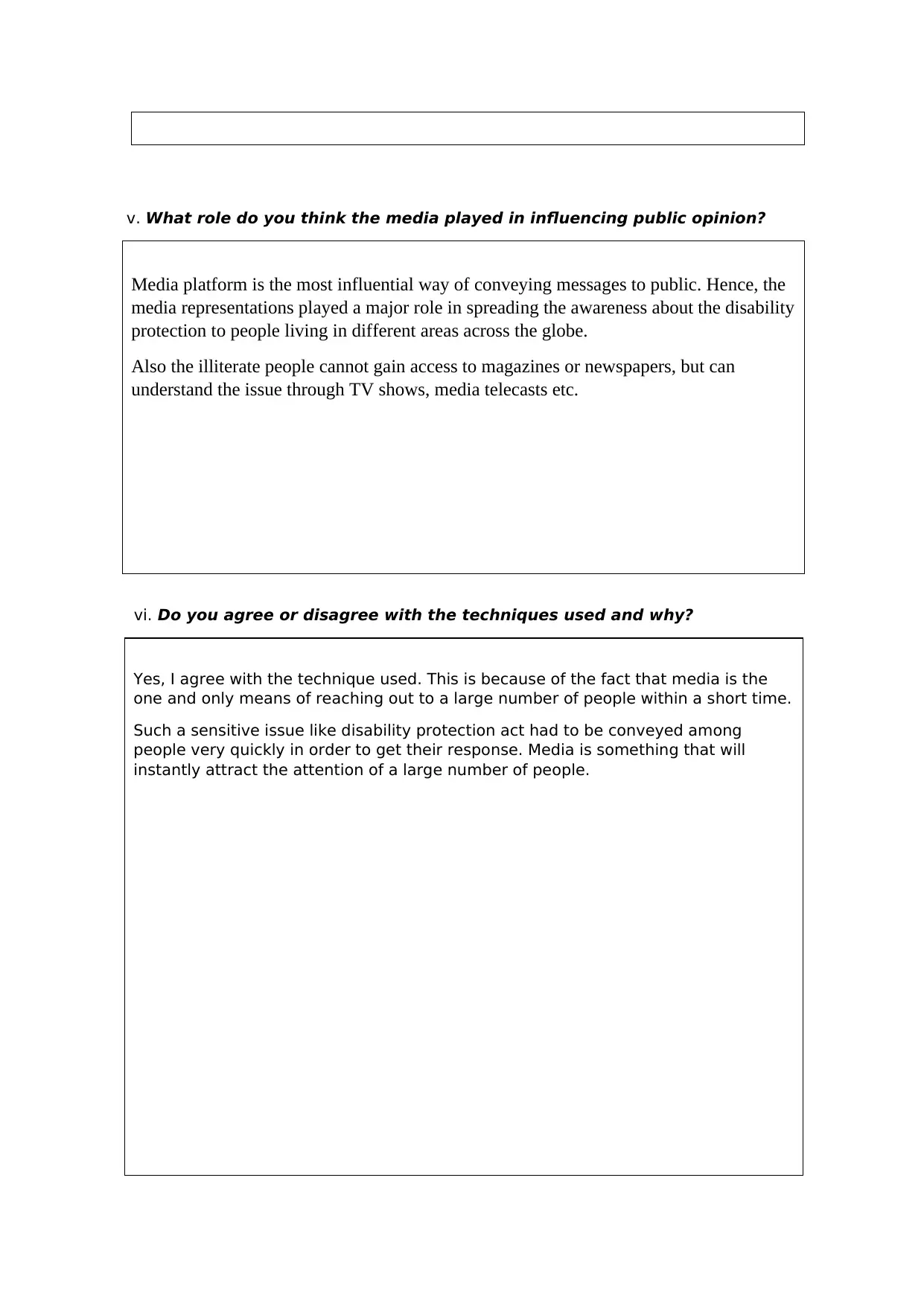
v. What role do you think the media played in influencing public opinion?
Media platform is the most influential way of conveying messages to public. Hence, the
media representations played a major role in spreading the awareness about the disability
protection to people living in different areas across the globe.
Also the illiterate people cannot gain access to magazines or newspapers, but can
understand the issue through TV shows, media telecasts etc.
vi. Do you agree or disagree with the techniques used and why?
Yes, I agree with the technique used. This is because of the fact that media is the
one and only means of reaching out to a large number of people within a short time.
Such a sensitive issue like disability protection act had to be conveyed among
people very quickly in order to get their response. Media is something that will
instantly attract the attention of a large number of people.
Media platform is the most influential way of conveying messages to public. Hence, the
media representations played a major role in spreading the awareness about the disability
protection to people living in different areas across the globe.
Also the illiterate people cannot gain access to magazines or newspapers, but can
understand the issue through TV shows, media telecasts etc.
vi. Do you agree or disagree with the techniques used and why?
Yes, I agree with the technique used. This is because of the fact that media is the
one and only means of reaching out to a large number of people within a short time.
Such a sensitive issue like disability protection act had to be conveyed among
people very quickly in order to get their response. Media is something that will
instantly attract the attention of a large number of people.
Paraphrase This Document
Need a fresh take? Get an instant paraphrase of this document with our AI Paraphraser
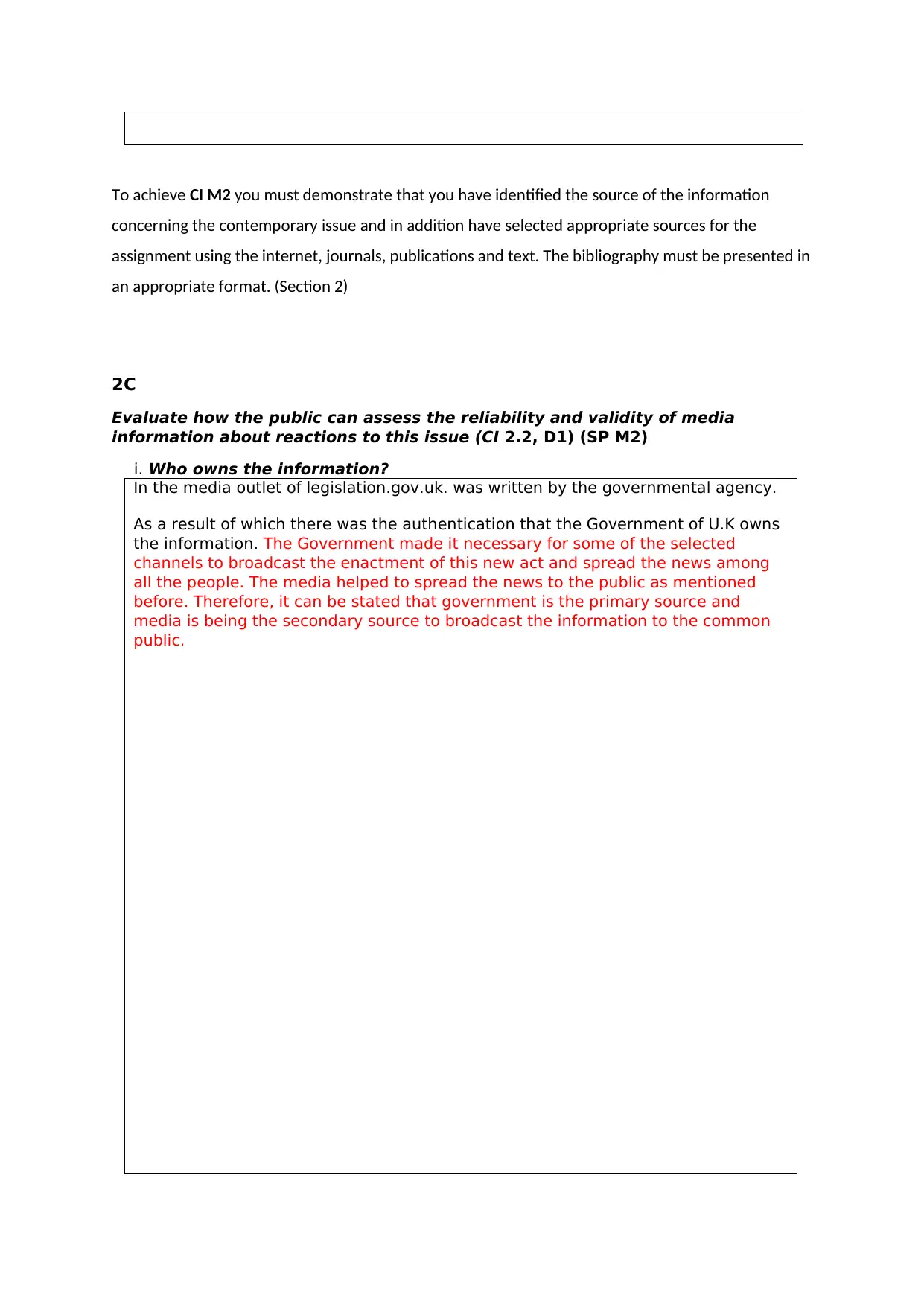
To achieve CI M2 you must demonstrate that you have identified the source of the information
concerning the contemporary issue and in addition have selected appropriate sources for the
assignment using the internet, journals, publications and text. The bibliography must be presented in
an appropriate format. (Section 2)
2C
Evaluate how the public can assess the reliability and validity of media
information about reactions to this issue (CI 2.2, D1) (SP M2)
i. Who owns the information?
In the media outlet of legislation.gov.uk. was written by the governmental agency.
As a result of which there was the authentication that the Government of U.K owns
the information. The Government made it necessary for some of the selected
channels to broadcast the enactment of this new act and spread the news among
all the people. The media helped to spread the news to the public as mentioned
before. Therefore, it can be stated that government is the primary source and
media is being the secondary source to broadcast the information to the common
public.
concerning the contemporary issue and in addition have selected appropriate sources for the
assignment using the internet, journals, publications and text. The bibliography must be presented in
an appropriate format. (Section 2)
2C
Evaluate how the public can assess the reliability and validity of media
information about reactions to this issue (CI 2.2, D1) (SP M2)
i. Who owns the information?
In the media outlet of legislation.gov.uk. was written by the governmental agency.
As a result of which there was the authentication that the Government of U.K owns
the information. The Government made it necessary for some of the selected
channels to broadcast the enactment of this new act and spread the news among
all the people. The media helped to spread the news to the public as mentioned
before. Therefore, it can be stated that government is the primary source and
media is being the secondary source to broadcast the information to the common
public.
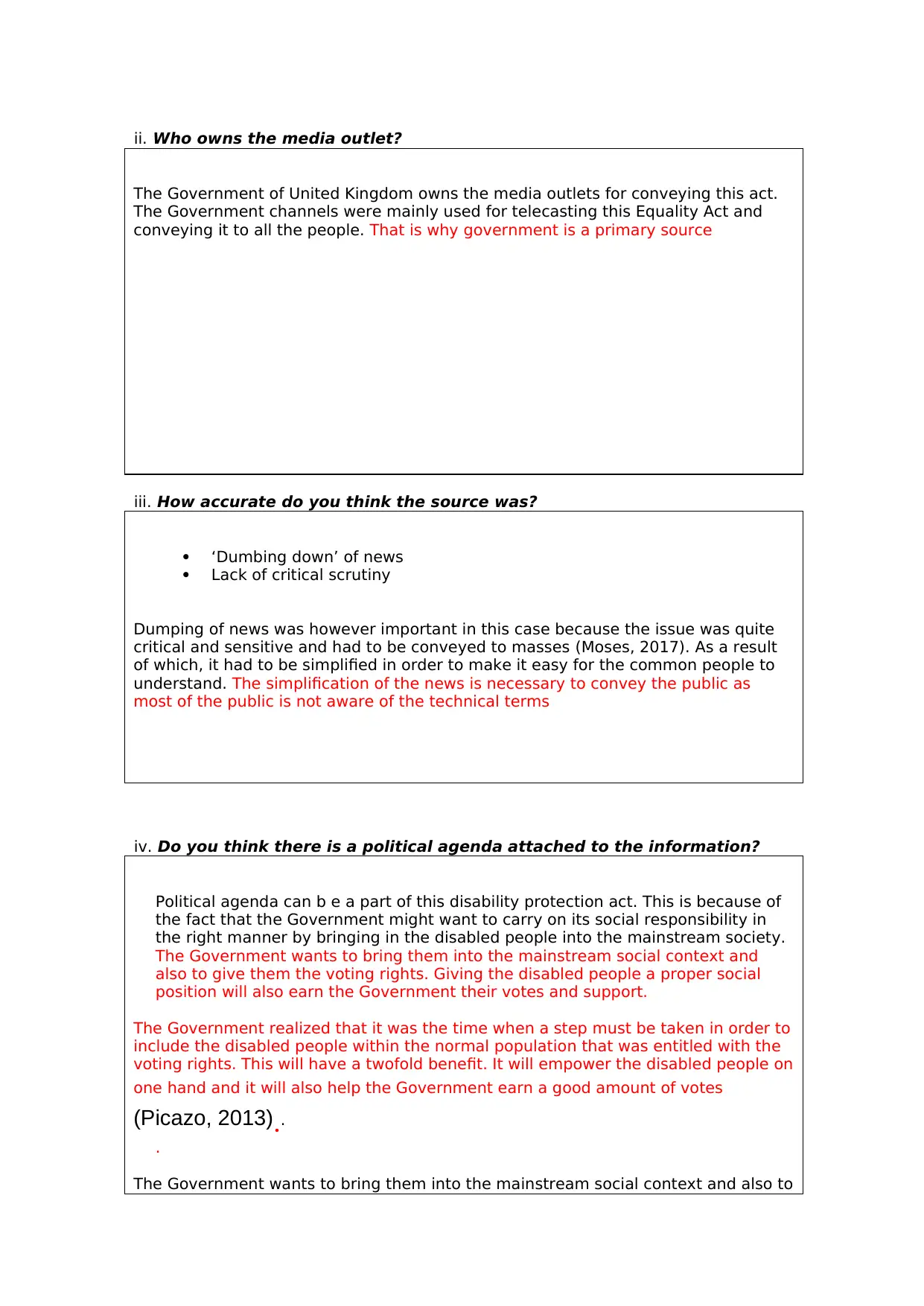
ii. Who owns the media outlet?
The Government of United Kingdom owns the media outlets for conveying this act.
The Government channels were mainly used for telecasting this Equality Act and
conveying it to all the people. That is why government is a primary source
iii. How accurate do you think the source was?
‘Dumbing down’ of news
Lack of critical scrutiny
Dumping of news was however important in this case because the issue was quite
critical and sensitive and had to be conveyed to masses (Moses, 2017). As a result
of which, it had to be simplified in order to make it easy for the common people to
understand. The simplification of the news is necessary to convey the public as
most of the public is not aware of the technical terms
iv. Do you think there is a political agenda attached to the information?
Political agenda can b e a part of this disability protection act. This is because of
the fact that the Government might want to carry on its social responsibility in
the right manner by bringing in the disabled people into the mainstream society.
The Government wants to bring them into the mainstream social context and
also to give them the voting rights. Giving the disabled people a proper social
position will also earn the Government their votes and support.
The Government realized that it was the time when a step must be taken in order to
include the disabled people within the normal population that was entitled with the
voting rights. This will have a twofold benefit. It will empower the disabled people on
one hand and it will also help the Government earn a good amount of votes
(Picazo, 2013)..
.
The Government wants to bring them into the mainstream social context and also to
The Government of United Kingdom owns the media outlets for conveying this act.
The Government channels were mainly used for telecasting this Equality Act and
conveying it to all the people. That is why government is a primary source
iii. How accurate do you think the source was?
‘Dumbing down’ of news
Lack of critical scrutiny
Dumping of news was however important in this case because the issue was quite
critical and sensitive and had to be conveyed to masses (Moses, 2017). As a result
of which, it had to be simplified in order to make it easy for the common people to
understand. The simplification of the news is necessary to convey the public as
most of the public is not aware of the technical terms
iv. Do you think there is a political agenda attached to the information?
Political agenda can b e a part of this disability protection act. This is because of
the fact that the Government might want to carry on its social responsibility in
the right manner by bringing in the disabled people into the mainstream society.
The Government wants to bring them into the mainstream social context and
also to give them the voting rights. Giving the disabled people a proper social
position will also earn the Government their votes and support.
The Government realized that it was the time when a step must be taken in order to
include the disabled people within the normal population that was entitled with the
voting rights. This will have a twofold benefit. It will empower the disabled people on
one hand and it will also help the Government earn a good amount of votes
(Picazo, 2013)..
.
The Government wants to bring them into the mainstream social context and also to
⊘ This is a preview!⊘
Do you want full access?
Subscribe today to unlock all pages.

Trusted by 1+ million students worldwide
1 out of 14
Related Documents
Your All-in-One AI-Powered Toolkit for Academic Success.
+13062052269
info@desklib.com
Available 24*7 on WhatsApp / Email
![[object Object]](/_next/static/media/star-bottom.7253800d.svg)
Unlock your academic potential
Copyright © 2020–2025 A2Z Services. All Rights Reserved. Developed and managed by ZUCOL.





